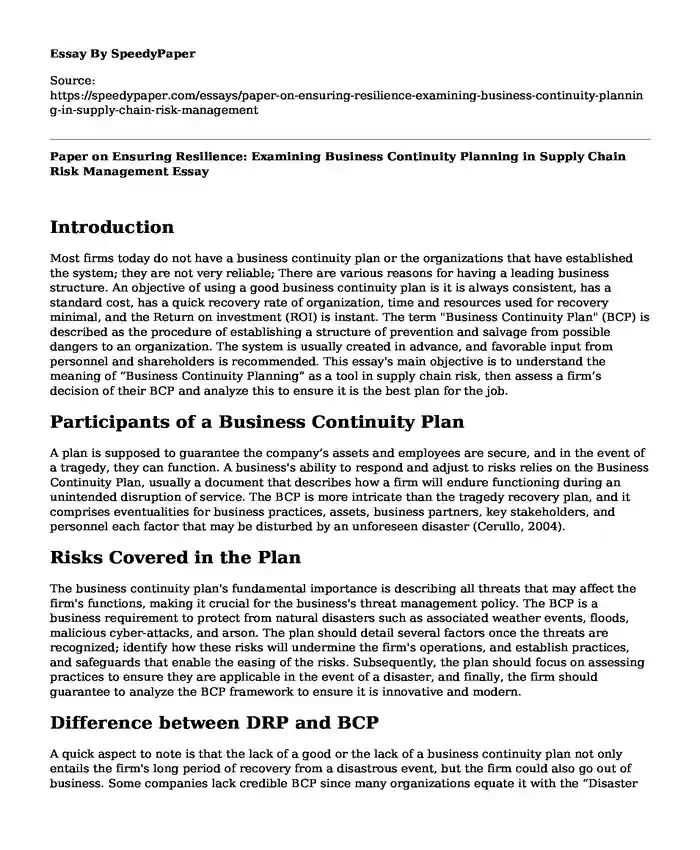
| Type of paper: | Essay |
| Categories: | Business Supply chain management Risk management |
| Pages: | 3 |
| Wordcount: | 742 words |
Introduction
Most firms today do not have a business continuity plan or the organizations that have established the system; they are not very reliable; There are various reasons for having a leading business structure. An objective of using a good business continuity plan is it is always consistent, has a standard cost, has a quick recovery rate of organization, time and resources used for recovery minimal, and the Return on investment (ROI) is instant. The term "Business Continuity Plan" (BCP) is described as the procedure of establishing a structure of prevention and salvage from possible dangers to an organization. The system is usually created in advance, and favorable input from personnel and shareholders is recommended. This essay's main objective is to understand the meaning of “Business Continuity Planning” as a tool in supply chain risk, then assess a firm’s decision of their BCP and analyze this to ensure it is the best plan for the job.
Participants of a Business Continuity Plan
A plan is supposed to guarantee the company’s assets and employees are secure, and in the event of a tragedy, they can function. A business's ability to respond and adjust to risks relies on the Business Continuity Plan, usually a document that describes how a firm will endure functioning during an unintended disruption of service. The BCP is more intricate than the tragedy recovery plan, and it comprises eventualities for business practices, assets, business partners, key stakeholders, and personnel each factor that may be disturbed by an unforeseen disaster (Cerullo, 2004).
Risks Covered in the Plan
The business continuity plan's fundamental importance is describing all threats that may affect the firm's functions, making it crucial for the business's threat management policy. The BCP is a business requirement to protect from natural disasters such as associated weather events, floods, malicious cyber-attacks, and arson. The plan should detail several factors once the threats are recognized; identify how these risks will undermine the firm's operations, and establish practices, and safeguards that enable the easing of the risks. Subsequently, the plan should focus on assessing practices to ensure they are applicable in the event of a disaster, and finally, the firm should guarantee to analyze the BCP framework to ensure it is innovative and modern.
Difference between DRP and BCP
A quick aspect to note is that the lack of a good or the lack of a business continuity plan not only entails the firm's long period of recovery from a disastrous event, but the firm could also go out of business. Some companies lack credible BCP since many organizations equate it with the “Disaster Recovery Plan” (DRP), which is relatively different. The main difference between the two is the disaster recovery plan concentrates primarily on repairing the IT practices and structure after a disaster (DRP only contains one part of the BCP) while the BCP entails the endurance of the whole firm (Snedaker, 2013).
An Illustration of a Firm’s BCP
The paramount significance of the BCP is to confirm a company's checklist that consists of inventory, equipment, and information backup (online), they might also recognize the plan supervisors (with the contact details for emergency respondents), website backup (IT guys) and key stakeholders (Blos, 2010). For example, a firm's administration has picked non-plausible recovery tactics, and this is mainly due to the business needs not being followed where the manager failed to discuss it with the relevant stakeholders and thus lacked important input. Therefore, the company’s business continuity plan flopped because of the failure of the firm’s organization of the recovery stakeholders, the failure to develop a relocation plan, and the strategy of introducing tests and exercises for warranting the BCP's success.
References
Blos, M., Wee, H. M., & Yang, J. (2010). Analyzing the external supply chain risk driver competitiveness: a risk mitigation framework and business continuity plan. Journal of Business Continuity & Emergency Planning, 4(4), 368-374. https://www.ingentaconnect.com/content/hsp/jbcep/2010/00000004/00000004/art00008
Cerullo, V., & Cerullo, M. J. (2004). Business continuity planning: a comprehensive approach. Information Systems Management, 21(3), 70-78. https://www.tandfonline.com/doi/pdf/10.1201/1078/44432.21.3.20040601/82480.11
Snedaker, S. (2013). Business continuity and disaster recovery planning for IT professionals. Newnes. https://books.google.com/books?hl=en&lr=&id=vT8TAAAAQBAJ&oi=fnd&pg=PP1&dq=difference+between+a+disaster+recovery+plan+and+a+business+continuity+plan&ots=d1syd66b60&sig=RnyDnzKxZJ80iYv-9_3-Vfgoc-w
Cite this page
Paper on Ensuring Resilience: Examining Business Continuity Planning in Supply Chain Risk Management. (2024, Jan 08). Retrieved from https://speedypaper.com/essays/paper-on-ensuring-resilience-examining-business-continuity-planning-in-supply-chain-risk-management
Request Removal
If you are the original author of this essay and no longer wish to have it published on the SpeedyPaper website, please click below to request its removal:
- Project Charter Essay Sample
- Paper Example on Brand Management for Nations
- Free Essay: Analysis of Malaysian and Singaporean Domino Pizza Advertisements
- Paper Example: Accountability Gap
- Paper Example: Organizational Behavior and Leadership in 21st Century
- Paper Example on The Role of the Federal Reserve in Inflation Control
- Shortage in Venezuela after Covid-19 - Essay Sample
Popular categories




